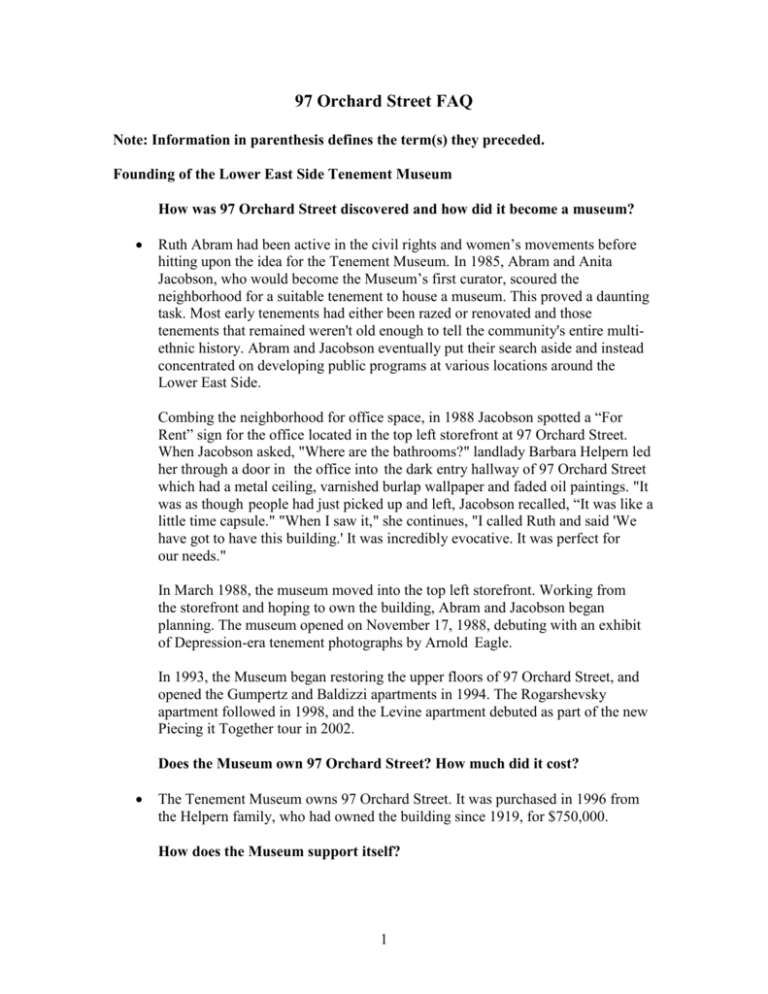97 Orchard Street FAQ
advertisement

97 Orchard Street FAQ Note: Information in parenthesis defines the term(s) they preceded. Founding of the Lower East Side Tenement Museum How was 97 Orchard Street discovered and how did it become a museum? Ruth Abram had been active in the civil rights and women’s movements before hitting upon the idea for the Tenement Museum. In 1985, Abram and Anita Jacobson, who would become the Museum’s first curator, scoured the neighborhood for a suitable tenement to house a museum. This proved a daunting task. Most early tenements had either been razed or renovated and those tenements that remained weren't old enough to tell the community's entire multiethnic history. Abram and Jacobson eventually put their search aside and instead concentrated on developing public programs at various locations around the Lower East Side. Combing the neighborhood for office space, in 1988 Jacobson spotted a “For Rent” sign for the office located in the top left storefront at 97 Orchard Street. When Jacobson asked, "Where are the bathrooms?" landlady Barbara Helpern led her through a door in the office into the dark entry hallway of 97 Orchard Street which had a metal ceiling, varnished burlap wallpaper and faded oil paintings. "It was as though people had just picked up and left, Jacobson recalled, “It was like a little time capsule." "When I saw it," she continues, "I called Ruth and said 'We have got to have this building.' It was incredibly evocative. It was perfect for our needs." In March 1988, the museum moved into the top left storefront. Working from the storefront and hoping to own the building, Abram and Jacobson began planning. The museum opened on November 17, 1988, debuting with an exhibit of Depression-era tenement photographs by Arnold Eagle. In 1993, the Museum began restoring the upper floors of 97 Orchard Street, and opened the Gumpertz and Baldizzi apartments in 1994. The Rogarshevsky apartment followed in 1998, and the Levine apartment debuted as part of the new Piecing it Together tour in 2002. Does the Museum own 97 Orchard Street? How much did it cost? The Tenement Museum owns 97 Orchard Street. It was purchased in 1996 from the Helpern family, who had owned the building since 1919, for $750,000. How does the Museum support itself? 1 The Museum supports itself through a combination of fundraising and earned income. Funding obtained from corporate and union grants, foundation grants, government grants, individual contributions and memberships, and special events comprise more than half of the Museum’s financial support. Earned income from shop sales, admissions for public tours and groups, the theatre program, shoots and space rental for parties, International Coalition revenues, and rental income comprise the remainder. 97 Orchard Street Was 97 Orchard Street the first tenement to be built on the block? By 1828, there were structures on all thirteen lots on the western side of Orchard Street between Broome and Delancey. Except for the church and the building on the corner of Broome Street, which was probably a multifamily residence with a store on the ground floor, all were mainly residential. For the most part, these were two-to-three story wood frame dwellings which, by the 1850s were being used as multifamily residences. Initial development of the 97 Orchard Street lot began with the erection of a Reformed Dutch Church in 1828, which stood on what is today 95, 97, and 99 Orchard Street. In 1860, the Dutch Reformed congregation sold the church to a Universalist congregation who not long after sold it again to the Second Reformed Presbyterian Church. Three years later, in 1863, the property was purchased by Lukas Glockner, Adam Strum, and Jacob Walter. The new owners demolished the church structure, for the 1864 Orchard Street tax rolls list three new five-story tenements on the lots, one belonging to each of the buyers. As only one-fifth of the buildings located in the 10th ward were tenements, 95, 97, and 99 Orchard Streets are the earliest surviving tenements on the block bounded by Broome and Delancey. How did 97 Orchard Street end up situated on a smaller than typical lot? The typical Manhattan lot size of 25 x 100 was mandated by the 1811 Commissioners plan for the City of New York. On the Lower East Side, streets extending as far north as Houston (then North) Street were laid out in 1804, prior to the Commissioners plan, resulting in lot sizes of varying measurements, including the 25x 88 lot on which 97 Orchard Street now stands. What is the architectural detail on the façade, archways, and cornices of the buildings? The front façade of 97 Orchard Street is an extremely simple version of the Italianate style, the most popular style for buildings erected in New York City during the early 1860s. By the time 97 Orchard Street was built, the Italianate style, featuring arched openings for doors and windows, projecting stone lintels (a supporting wood or stone beam across the top of an opening, such as that of a window or door or fireplace), and foliate brackets (decorated with carved leaves), 2 had filtered down to even the most modest projects. At 97 Orchard Street, the brick façade of the upper floors is ornamented by segmental-arch window openings (the circular arch above each window in which the inner circle is less than a semicircle) with brownstone trim. An Italianate projecting-metal cornice caps the façade and is coated with brownstone-colored sand paint. Upon what is the reproduction of the stoop based? 97 Orchard Street’s stoop and wooden façade was restored in 2001 to look as it did circa 1905 when then landlords Barnet Goldfein and Benjamin Posner gave the stoop and storefronts a facelift. Using a circa 1915 photo of the Rogarshevsky family taken in front of 97 Orchard Street, architects Li/Saltzman traced and compared elements in the image with extant examples in the vicinity to responsibly restore the stoop and façade. Were there always fire escapes on the building? Did they look like the fire escapes we see today? As required by the 1862 law that established the Department of Buildings, an iron fire escape was originally attached to the front of 97 Orchard Street. An early example of fire escape design, it is known as a fire ladder. Instead of the stairways found on most New York fire escapes, the example at 97 Orchard St. employed a vertical ladder. It was removed in the late 1970s or early 1980s. The Museum replaced the fire escape in 1997, with a replica that mimics the original design of the landing barriers, but uses stairs instead of ladders. The use of fire ladders is prohibited by the Fire Department, but landlords with original fire ladders are not required to replace them. Was there only a fire escape on the front of the building in the 1860s? In 1863 there was a fire escape serving the south apartments and a party balcony serving the north apartments on the rear of 97 Orchard Street These party balconies connected the north apartment of each floor with its neighbor at 99 Orchard Street. In case of a fire at 97 Orchard Street, the residents were supposed to climb onto the balcony and escape by entering the apartment in the adjacent building. While the party balconies are extant, the south fire escape was removed and replaced with the fire tower that remains today. What were some of the retail businesses that that operated out of 97 Orchard Street through the years? Other than Schneider’s Saloon, we know few details about the shops at 97 Orchard Street during the 19th century. During the 20th century, some of the shops included the Auction Exchange of Herman and Marcus Brandies, the Orchard Printing Company, Fischer and Schimmel Hosiery, the Seaboard Importing Co., Felty’s Hats, and the stove and range repair shop of Morris and Irving Claman. 3 When was Schneider’s Saloon in operation and which storefront did it occupy? Schneider’s Saloon was in operation at 97 Orchard St. from 1865 to 1886. We are not yet sure whether the saloon occupied the basement-level left or right storefront. How does the Museum know when specific structural changes occurred in the building? The Museum gained knowledge of specific structural changes that occurred in the building from New York City Department of Buildings records (such as permits for repairs and alterations), paint analyses, and building analyses conducted by professional architects. What do we know about the wallpaper in 97 Orchard Street? Around 1905, the main hall on the first floor was redesigned with the addition of an inexpensive, but durable covering of burlap painted red, and later shellacked with a brown varnish. In the late 1880s, wallpaper began to replace paint on the front room walls of apartments in 97 Orchard Street. We believe the landlord arranged for the walls to be papered probably every time new tenants moved into an apartment. Landlords may have opted to use wallpaper instead of paint because with its busy patterns, it better hid imperfections in the walls. In some cases tenants apparently added wallpaper in order to beautify the room. In some of the apartments at 97 Orchard Street, up to 22 layers of wallpaper were discovered by paper conservator Reba Fishman Snyder. 7-10 layers of paint were found underneath the wallpaper in the front rooms. The walls of the kitchens and bedrooms exhibit an average of 37 to 39 layers of paint. Because the building was occupied for 72 years (from 1864 through 1935), simple statistical analysis shows that the interior surfaces were painted approximately every two years. A textile and wallpaper company called Scalamandre reproduced the wallpapers in the Gumpertz, Rogarshevsky, and Levine apartments pro bono for the Tenement Museum. The papers are available for sale by Scalamandre. When were the metal ceilings installed, what are they made from, and why did the landlord chose to put them up? The ceilings in the hallways throughout 97 Orchard Street are covered in pressed metal, made from an alloy of steel and iron. These ceilings were installed circa 1900. Metal ceilings were popular because they were easier to maintain than easily damaged plaster. Different patterns are visible in the halls of 97 Orchard 4 Street, since sections were often patched with a piece of metal that did not match the original. What did the privies at 97 Orchard Street look like? When Lucas Glockner constructed 97 Orchard Street he provided toilet facilities that, however primitive by today’s standards, were more advanced than required by law. Glockner constructed a privy vault or an outdoor group of toilets with a common waste compartment that was connected to a sewer. It had a mechanism that permitted someone to regularly flush out the vault. Such vaults were later referred to as school sinks, so named because of their popularity at public schools. During excavation of the privies in 1993, the Museum’s archaeologist discovered in the northwestern corner of the yard what she believes are three toilet compartments, each measuring about 2’-6’’ wide by 3’-9’’ deep, at 97 Orchard Street. These appear to have shared a wall with the privies at 99 Orchard Street, aligned in two abutting rows of three running along the northern lot line between nos. 97 and 99. Each compartment had a wood seat and a door with some sort of slit or hole for light and ventilation. During the 1860s, how many privies were required by law? The 1867 Tenement House Act required that one toilet or privy be provided for every 20 people, and that privies be connected to sewers where these were available. How old are the toilets in 97 Orchard Street? According to the Real Estate Record and Guide, which contains a list of alterations made to buildings in 1905, the toilets and adjacent airshaft were installed in 1905. Was there a law that was passed during the time that 97 Orchard Street was open to residents which required the installation of one toilet for each apartment? There was no law passed during the time that 97 Orchard Street was open to residents which required the installation of a toilet in each apartment. While the 1929 Multiple Dwellings law mandated the installation of one toilet in each apartment for all newly constructed buildings, neither the 1929 Multiple Dwellings Laws, nor the 1930 or 1934 amendments to the law, required the toilets in the apartments of older tenements. Where did residents get their water? By the 1860s, water delivered from upstate New York by the Croton Aqueduct had become widely available in New York City. We believe water from a 5 backyard hydrant or spigot was available to the residents of 97 Orchard Street when the building opened in 1864. There tenants filled buckets and basins, hauling the heavy receptacles to their apartments. When was gas lighting introduced into the building? Gas lighting was introduced into the building sometime between 1896 and 1905, possibly to conform to the 1901 Tenement House Act which required landlords to have a lamp burning from sunset to sunrise near the stair on the entrance and the second floor. A cap on a gas pressure reduction device on the first floor is inscribed “Property of the American Gas Reduction Company, NY”; this firm entered business in 1896. Each tenant would have paid for gas individually and each apartment would have had a coin-operated meter that had to be fed in order to turn on the gas. When was electricity introduced into the building? Electricity was introduced into 97 Orchard Street at some point after 1918, the patent date on the electrical panels located at the rear of the hall on the first floor. One former resident remembers that electricity was added in 1924, the year he entered kindergarten. When and why were the fireplaces boarded up in the parlors? We believe all of the fireplaces in the parlors of 97 Orchard Street were sealed by the late 1880s. These alterations were completed at different times and in different ways—in some cases the openings were simply boarded up, in others the existing mantels were removed and used as a baseboard, and the entire wall replastered. With a stove operating more or less simultaneously in the kitchen of the small apartments, it is unlikely that an additional heat source was really needed, and the drafts produced from the chimneys may have been counterproductive to attempts to heat the rooms. It is evident from the ceiling in the Gumpertz apartment that the wall was moved between the parlor and the kitchen. When did this happen and why? During the 19th century, the most dramatic change to the apartments at 97 Orchard Street was the enlargement of the kitchens. Circa 1895, the wall between the kitchen and the parlor was moved two feet four inches into the parlor. This costly alteration appears to have occurred in conjunction with the addition interior windows between the kitchen and parlor, cupboards in the kitchens, and water in the apartments. As a result of the 1901 Law, did the landlords have to reconstruct the southern side of the building in order to create an air shaft? 6 In compliance with the 1901 Tenement House Act, landlords Barnet Goldfein and Benjamin Posner commissioned architect Otto Reissmann to alter 97 Orchard in 1905. Improvements at that time included the construction of a fireproof airshaft on the south side of the building with two adjoining water closets on each floor. The loss of space in affected apartments required that partitions between kitchens and bedrooms be moved. Are the closets in each apartment original? The wood closets located in the front room of each apartment are original features that date to 1864. Circa 1895-96, the closets were moved when the wall between the parlor and kitchen were shifted in order to accommodate the installation of plumbing and soapstone tub sinks. In 1887, New York State passed a law mandating the installation of water into the apartments erected after May 14, 1867 and permitting the New York City Health Department to order the installation of water in older tenements such as 97 Orchard Street. The owner of 97 Orchard Street probably did not actually install the water system until after 1895 when the New York State Court of Appeals upheld the legality of the 1887 law which had been challenged by Trinity Church, owner of a great deal of land occupied by old and substandard tenements and converted rowhouses. Who provided the stoves in each apartment? The wood- or coal-burning cast-iron stoves used by residents of 97 Orchard Street to cook and heat their homes was generally the property of the tenant and not the landlord. The residents themselves would have been responsible for carrying the stoves upstairs to their respective apartments. The heavy, cumbersome stoves, however, are comprised of interlocking pieces that can be disassembled for easy transport and later put back together. Were there ever any fires at 97 Orchard Street? Documents indicate that the Fire Department responded to at least 7 fires at 97 Orchard Street between 1863 and 1935—one in 1863, two in 1899, two in 1901, one in 1909, and one in 1934. These records give no indication that the fires caused any more than insignificant damage. How many landlords owned 97 Orchard Street? Did any besides Lucas Glockner live in the building? Approximately fifteen landlords owned 97 Orchard Street between 1863 and 1994. Like the residents of 97 Orchard Street, the building’s owners were immigrants and most worked in the garment industry before getting involved in real estate. These landlords tended to be mobile, moving from home to home, buying property and quickly selling it. Only four landlords owned 97 Orchard Street for more than five years. The landlords of 97 Orchard Street were usually 7 tenement dwellers themselves. Sometimes they lived in East Harlem or Yorkville tenements, but they were just as likely to live in a tenement apartment around the corner from 97 Orchard Street. With the exception of Lucas Glockner, it seems that none of the other owners lived at 97 Orchard Street. How was it that 97 Orchard Street was left untouched for over fifty years after the building was shut down as a place of residence? The closure and resultant vacancy of 97 Orchard Street may have been the result of the difficulty of renting apartments in older tenements on the Lower East Side, coupled with the demands of a law passed in 1934 that would have required the removal of all wood in the public halls, including the replacement of the entire wood staircase with metal of some other incombustible material. In addition, the passage of restrictive immigration laws in 1924 almost completely ended the flow of new residents to the Lower East Side. This was coupled with the fact that as older immigrants prospered, they moved out of the Lower East Side to less densely populated neighborhoods, especially in Brooklyn and the Bronx, that had newer buildings of higher quality. Indeed, between 1920 and 1930, the neighborhood’s population declined by 40%. Behind the Scenes How do we choose the families and themes explored in each apartment? The Museum selects particular family stories that are substantially documented by historical records, to demonstrate the building’s ethnic and religious diversity, the chronological span of its habitation and, most importantly, their ability to raise pressing and sometimes controversial contemporary issues. How many descendants of 97 Orchard Street has the Museum contacted? The Tenement Museum has been able to contact over 200 descendants of former 97 Orchard Street residents. What are some of the objects that were discovered in the apartments? Over 2,000 objects were discovered in the apartments include a pillow, a toothbrush, earrings, hairpins, dishes, shoes, and books, among others. Some of the objects found at 97 Orchard Street are displayed in the ruin apartment on the third floor. What objects were actually owned by former residents of 97 Orchard Street? Confino Apartment: 1. Manta, a bright red blanket that looks like a shag carpet, on metal bed was 8 donated by Solomon Confino, a cousin of Victoria’s, who also lived at 97 Orchard Street. Baldizzi Apartment: 1. 2. 3. 4. 5. 6. 7. 8. Linit starch box – on back of sink Cloth napkins– on kitchen table Baking pan – grey enameled, in sink Bedspread – folded on chair in front room (blue) Dish towels – monogrammed, hanging on string over sink Vaporizer – in north cabinet Table runners (2) – in suitcase and adjacent crate in front room Colander – on kitchen counter Rogarshevsky Apartment 1. 2. White enamel bucket underneath the laundry tub in kitchen Egg beaters hanging from the back room window in kitchen © 2005 Lower East Side Tenement Museum 9





